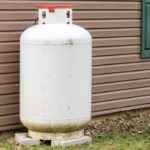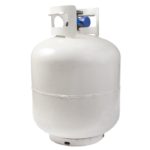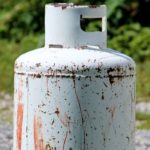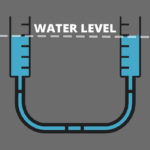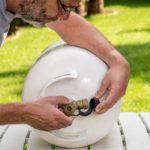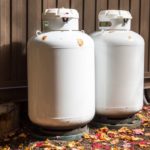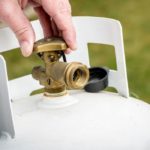It happens to us all: you go to start your grill and you can’t get any flames to appear. In most cases, your propane tank is to blame. But how can you know if it’s just empty or something else is going on? How heavy should an empty propane tank be, anyway?
Empty propane tanks are much lighter than full tanks, since propane weighs around 4.7 pounds per gallon. Check your tank’s collar for the tare (empty) weight, abbreviated as T.W., which indicates the weight of the tank by itself. The standard 20-pound propane tank has a tare weight of 17 pounds.
Propane is a clean-ish burning fuel that is a common staple in many households. It’s not just used for grilling, but also for heating homes and running appliances. If you think your tank might be low, what do you need to know? Read on to learn more about empty propane tanks.
Are Propane Tanks Still Very Heavy When They’re Empty?

If you’re looking to fire up the grill, you may give your propane tank a quick shake and tug to see how much is left in the vessel. While this could certainly help you gauge your propane levels, are you familiar with how much an empty tank weighs? One question that often gets asked is how heavy a propane tank will be when it’s empty.
When it comes to empty propane tanks, they are much lighter than filled tanks. Propane has a weight. Much like water, or other liquids, propane adds some significant weight to a tank. If there is no propane left, you’ll have less weight to deal with.
If you’re looking for exact answers, you can always check your tank for the specifics. Most tanks have a tare weight listed, abbreviated as T.W. You should see this somewhere on the tank’s collar. The tare weight is the weight of the tank without the propane. Most 20-pound tanks have a tare weight of around 17 pounds. The confusion in the naming comes from how much propane the tank can actually hold.
A 20-pound tank can hold 20 pounds of propane, which is around 4.7 gallons of propane. So, in reality, the full tank weighs 17 pounds plus the 20 pounds of propane. As you can probably imagine, this is a significant weight difference.
For reference, a 30-pound tank weighs around 26 pounds when empty. A 40-pound tank, meanwhile, weighs around 30 pounds when empty.
How Can You Tell if Your Propane Tank Is Almost Empty?
If you’re curious as to how much gas you have left in the tank, how can you find this information? Since a lot of conventional tanks don’t have a content gauge, it can be a challenge to get to the bottom of this question. Moreover, you don’t want to go through the hassle of weighing your tank every time you go to grill. So, what can you do?
A simple test to gauge the content of your tank is to use warm water. Pour the water down the side of the tank. Be sure to stay away from the nozzle or other components. Next, run your hand down the side of the tank and feel for temperature differences. The top of the cool spot indicates your level of propane.
Why does this work? Well, when you put warm water on the side of the tank, the propane will try to absorb that heat. Without getting too much into the thermodynamics of it all, it basically means that the cool spot is where the propane level starts.
Another method is to install an inline gauge. You can easily add a unit like this one (on Amazon) without breaking the bank or needing professional assistance.
What Should You Do if Your Propane Tank Is Empty?
If you’re running on low, and you know it, what should you do? The last thing you want is your grill time to be cut short because your propane ran out. It happens all the time. So, what should you do if your tank hits empty?
If your propane tank is empty, you have a few options:
- Get a refill or exchange
- Have a propane service fill your tank (for bigger tanks)
Almost every area has a propane service business. While many of us use propane for grilling outdoors, the clean-burning fuel has many additional applications. In fact, many homes rely on propane for heating. Most likely, you have a local certified dealer that will be happy to fill or exchange your tanks.
If you use propane for heating, you most likely have a big tank somewhere on your property. These tanks can be very large — around 200 pounds or more. They usually sit horizontally. If you have one of these tanks, you’ll need a professional service to come through and fill your tank.
Don’t wait until you run out to refill. If you can, try to schedule a refill or have your tank exchanged before your next use. This will ensure proper operation when you need it most.
Is It Cheaper to Exchange or Refill an Empty Propane Tank?
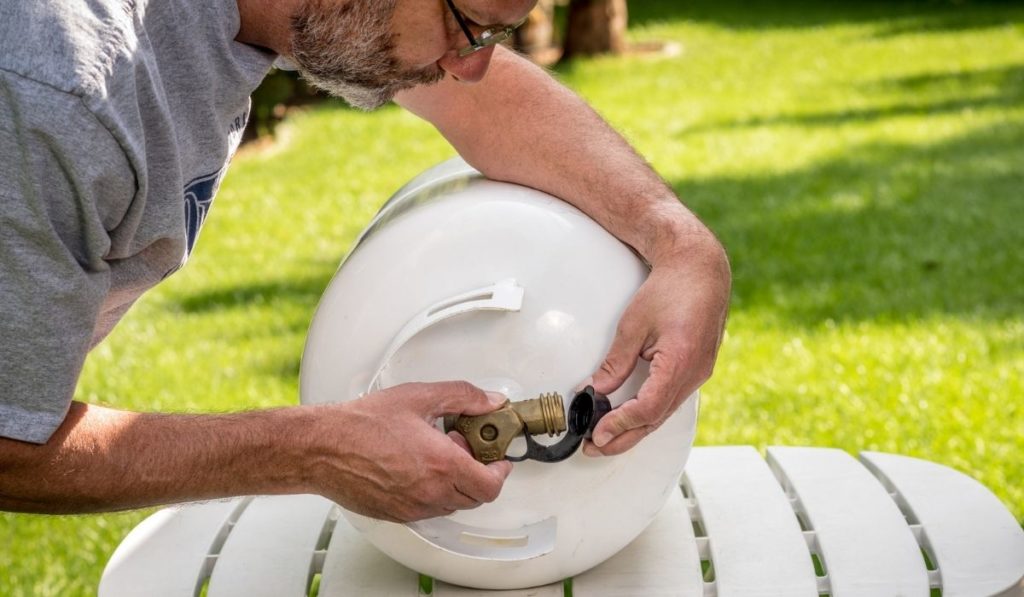
If you’re staring at an empty tank, the next question is whether to exchange it or refill it. Cost is certainly a factor, but so is convenience.
In most cases, getting a propane tank refilled is much cheaper than an exchange. You also benefit from getting more gas in some cases. This will depend on other factors, like ambient temperature.
If you choose to exchange the tank, you’ll get in and out much quicker. Many convenient stores and gas stations offer an exchange option. While pricey, this is certainly the most convenient of all the options.
When it comes to tanks over 40 pounds, a refill is the only way to go. This is especially true for very large tanks for which exchange isn’t an option.

